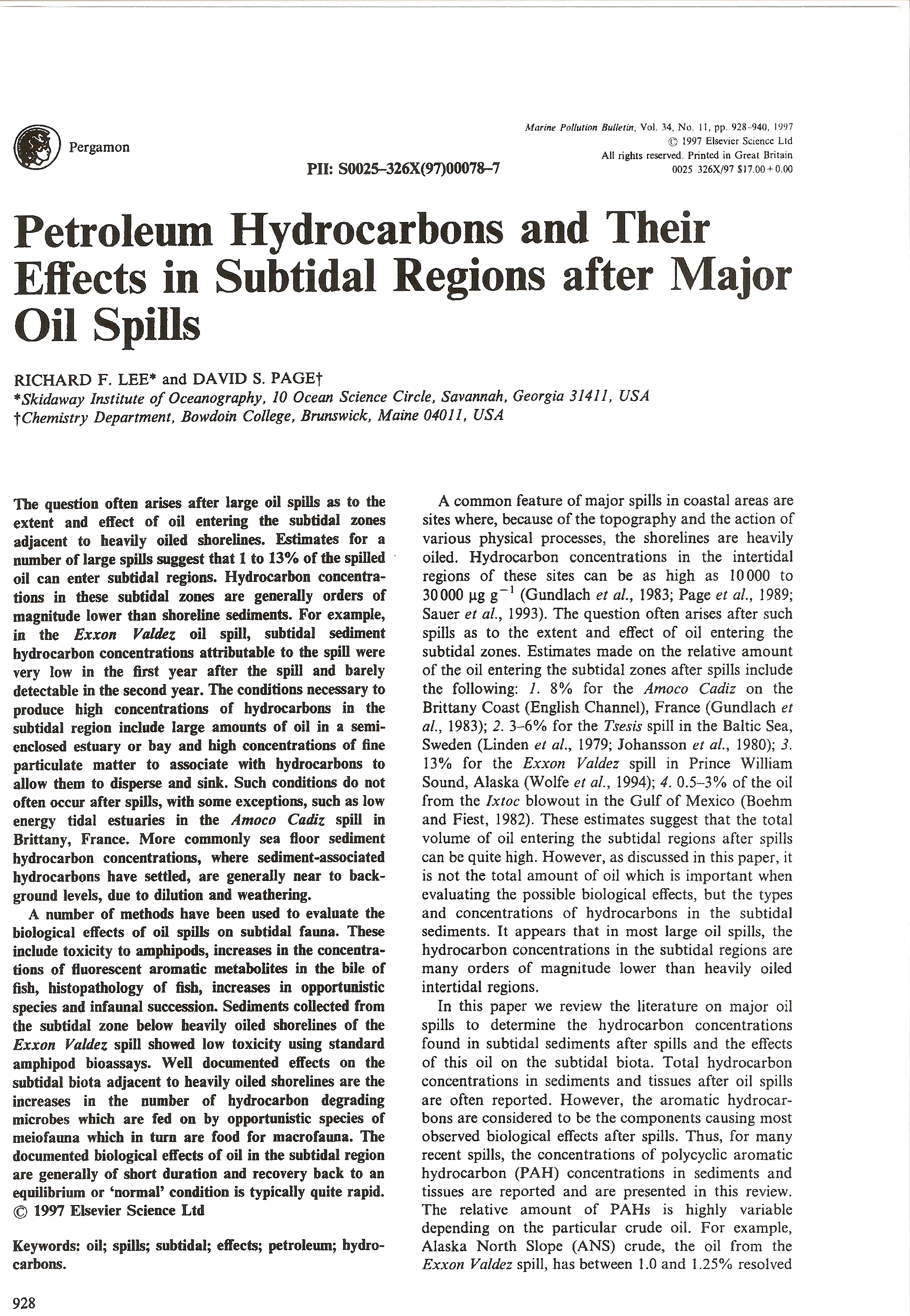scan0022 (5)


Pergamon
Pil: S0025-326X(97)00078-7
Marinę Pollution Bulletin, Vol. 34, No. II, pp. 928-940, 1997 © 1997 EIsevier Science Lid Ali rights reserved. Printed in Great Britain 0025 326X/97 SI7.00+ 0.00
Petroleum Hydrocarbons and Their Effects in Subtidal Regions after Major Oil Spills
RICHARD F. LEE* and DAVID S. PAGEj
*Skidaway Institute of Oceanography, 10 Ocean Science Circle, Savannah, Georgia 31411, USA f Chemistry Department, Bowdoin College, Brunswick, Maine 04011, USA
The qnestion often arises after large oil spills as to the extent and effect of oil entering the subtidal zones adjacent to heavily oiled shorelines. Estimates for a number of large spills suggest that 1 to 13% of tlie spilled oil can enter subtidal regions. Hydrocarbon concentra-tions in these subtidal zones are generally orders of magnitude lower than shoreiine sediments. For example, in tbe Exxon Valdez oil spili, subtidal sediment hydrocarbon concentrations attributable to tbe spili were very Iow in the first year after the spili and barely detectable in the second year. The conditions necessary to produce high concentrations of hydrocarbons in the subtidal region include large amounts of oil in a semi-enclosed estuary or bay and high concentrations of fine particulate matter to associate with hydrocarbons to allow them to disperse and sink. Such conditions do not often occur after spills, with some exceptions, such as Iow energy tidal estuaries in the Amoco Cadiz spili in Brittany, France. Morę commonly sea floor sediment hydrocarbon concentrations, where sediment-associated hydrocarbons have settied, are generally near to back-ground levels, due to dilution and weatiiering.
A number of methods have been used to evaluate the biological effects of oil spills on subtidal fauna. These include toxicity to amphipods, inereases in the concentrations of fluorescent aromatic metabolites in the bile of fish, histopathology of fish, inereases in opportunistic species and infaunal succession. Sediments collected from the subtidal zonę below heavily oiled shorelines of the Exxon Yaldez spili showed Iow toxicity using standard amphipod bioassays. Weil documented effects on the subtidal biota adjacent to heartiy oiled shorelines are the inereases in the number of hydrocarbon degrading microbes wbich are fed on by opportunistic species of meiofauna which in tura are food for macrofauna. The documented biological effects of oil in the subtidal region are generally of short duration and recovery back to an equilibrium or ‘normal’ condition is typically quite rapid. © 1997 Elserier Science Ltd
Keywords: oil; spills; subtidal; effects; petroleum; hydrocarbons.
A common feature of major spills in coastal areas are sites where, because of the topography and the action of various physical processes, the shorelines are heavily oiled. Hydrocarbon concentrations in the intertidal regions of these sites can be as high as 10000 to 30000 pg g~' (Gundlach et al., 1983; Page et al, 1989; Sauer et al., 1993). The ąuestion often arises after such spills as to the extent and effect of oil entering the subtidal zones. Estimates madę on the relative amount of the oil entering the subtidal zones after spills include the following: 1. 8% for the Amoco Cadiz on the Brittany Coast (English Channel), France (Gundlach et al., 1983); 2. 3-6% for the Tsesis spili in the Baltic Sea, Sweden (Linden et al., 1979; Johansson et al., 1980); 3. 13% for the Exxon Yaldez spili in Prince William Sound, Alaska (Wolfe et al., 1994); 4. 0.5-3% of the oil from the Ixtoc blowout in the Gulf of Mexico (Boehm and Fiest, 1982). These estimates suggest that the total volume of oil entering the subtidal regions after spills can be ąuite high. However, as discussed in this paper, it is not the total amount of oil which is important when evaluating the possible biological effects, but the types and concentrations of hydrocarbons in the subtidal sediments. It appears that in most large oil spills, the hydrocarbon concentrations in the subtidal regions are many orders of magnitude lower than heavily oiled intertidal regions.
In this paper we review the literaturę on major oil spills to determine the hydrocarbon concentrations found in subtidal sediments after spills and the effects of this oil on the subtidal biota. Total hydrocarbon concentrations in sediments and tissues after oil spills are often reported. However, the aromatic hydrocarbons are considered to be the components causing most observed biological effects after spills. Thus, for many recent spills, the concentrations of polycyclic aromatic hydrocarbon (PAH) concentrations in sediments and tissues are reported and are presented in this review. The relative amount of PAHs is highly variable depending on the particular crude oil. For example, Alaska North Slope (ANS) crude, the oil from the Exxon Yaldez spili, has between 1.0 and 1.25% resolved
928
Wyszukiwarka
Podobne podstrony:
55750 scan0026 (4) Marinę Pollution Bulletin TABLE 3 Hydrocarbons concentrations in particles collec
60761 scan0034 (2) Marinę Pollution Bulletin Page, D. S., Foster, J. C., Pickett, P. M. and Gilfilla
11465 scan0028 (3) Marinę Pollution Bulletin their metabolites in invertebrates and fish from subtid
15846 scan0024 (4) Marinę Pollution Bulletin TABLE2 Concentrations of total petroleum hydrocarbons (
43959 scan0032 (4) Marinę Pollution BuUetin histopathology of fish, increases in opportunistic speci
18805 scan0030 (2) Marinę Pollulion Bulletin Petroleum hydrocarbons by fish. After metabolism by pha
scan0035 (12) MATERIAŁY I PRZYBORY " =7 Ryc. 97. Malując akrylami można bardzo szybko dokonywać
więcej podobnych podstron